I've been hunting for 60 years and in the course of that time I've learned a few things. First and foremost is that successful hunting—of any species, large or small—is fundamentally a "space/time" problem. You need to be in the right place at the right time prepared to take advantage of the situation whether you're after a deer, a squirrel, a duck, a moose, or anything else. Places where things "come together," where everything goes right, are what make the hunt successful. Such locations come to have special meaning because they produce memories associated with success.
I usually hunt on heavily wooded land: small plots (the largest is about 160 acres) that don't lend themselves to the spot-and-stalk tactics better suited to the "wide open spaces" of the western states. I've had some longer range hunting in Africa and there I found that I'm reasonably good at spot-and-stalk. But in 30+ years of hunting in Virginia—and for that matter, 60 years of hunting in the USA in general—only twice have I had a shot that was as much as 100 yards; only once by dumb luck did I do a successful stalk on a deer. Fifty yards is a long shot for me; thirty is more common; not infrequently the range can be measured in feet, not yards. Much beyond 30 yards in most places I can hardly see the game. This combination of forested land, leaf litter on the ground, and short sight lines means that perforce I am sitzjäger, a "sitting hunter."
TACTICS
My strategy is to find a good place, sit down, and do my justly-celebrated invisible act. (When I'm being invisible I'm so good at it, I can't even see myself.) In other words, I wait for the game to come to me. This is boring and makes for long hours on the stand but it works far more often than not: it's really the only thing that works consistently for me. Once I did do a successful stalk here in Virginia (which I've recounted below) but that was a fluke. By the way, I don't do treestands. I sit on the ground. That's just as effective and a lot safer than climbing a tree.
Sitting stock still for hours at a time is a learned skill, an art. It's one that I like to think I've more or less perfected, but however good I may be at invisibility and immobility, they would be useless if I didn't know where to sit. It's finding the best spot that takes effort and time. Animals, especially deer, don't move randomly. They know exactly where they are and if they're on the move they know exactly where they're going and exactly how to get there. The trick is to find out the route(s) they like and the spot(s) they want to be, then sit and wait for them to show up.
I'm convinced from long experience that animals don't see a sitting man as a threat unless they've been "educated" by being shot at and missed. I believe that most prey species are "hard wired" to recognize a certain "aspect ratio" of height to width as something threatening; but a sitting man isn't immediately recognized as dangerous. I've seen this in squirrels, deer, and groundhogs. On one farm I used to hunt there was a tree in the middle of a pasture with a groundhog burrow underneath; there was no "cover" at all for 100 yards. But if I saw a groundhog duck into the hole I could simply sit down 15 or so yards away, in plain view. Invariably he would come up for a look-see and in a few minutes emerge in front of me. A shotgun would do—and did—the trick, every time.
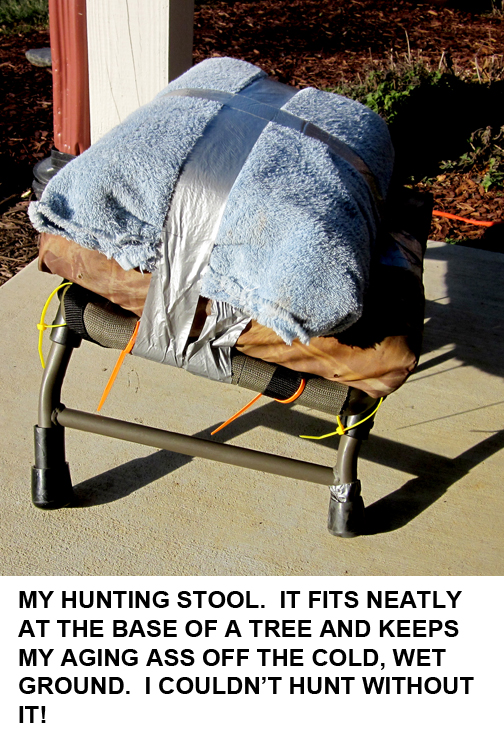 When I hunt a brand new location it can take a season or two before I dope things out, but I'm getting better at it. There are certain criteria to be met. I need to find a place that permits me to scan the area in front of me; it has to be one that prevents the game from "alerting" too soon; one that allows for changes in the wind, or better yet, where wind patterns are predictable. Comfort is another very real consideration: I need back support and I need to keep my butt off the ground. I have a low stool that permits the latter; and I always choose a place where I can lean against a tree. The tree serves not only to support my back but to provide some degree of visual screening. Wind is especially important when hunting deer, though not so much with other species. Deer have not-very-good eyesight but an exceptionally good sense of smell and phenomenal hearing. A deer can scent a human from amazing distances so that often the first indication I get that I've been "busted" is when one snorts a long distance away.
When I hunt a brand new location it can take a season or two before I dope things out, but I'm getting better at it. There are certain criteria to be met. I need to find a place that permits me to scan the area in front of me; it has to be one that prevents the game from "alerting" too soon; one that allows for changes in the wind, or better yet, where wind patterns are predictable. Comfort is another very real consideration: I need back support and I need to keep my butt off the ground. I have a low stool that permits the latter; and I always choose a place where I can lean against a tree. The tree serves not only to support my back but to provide some degree of visual screening. Wind is especially important when hunting deer, though not so much with other species. Deer have not-very-good eyesight but an exceptionally good sense of smell and phenomenal hearing. A deer can scent a human from amazing distances so that often the first indication I get that I've been "busted" is when one snorts a long distance away.
When I find a place that has the ideal combination of qualities I come back to it over and over in successive seasons. Even on the same property as I continue to hunt I "find" new spots: over 35 years in southwestern Virginia I've located many places. Inevitably I've given names to these spots. On a given plot of ground I may develop three or four specific spots, each of which acquires its own name. Some, alas, are no longer available to me but there are always other opportunities. In this essay I want to talk about some of these places, to recount some of the memorable events with which they've come to be associated.
While I mostly discuss my experiences in the context of hunting deer in this essay, everything is applicable to small game as well. Or for that matter to fishing, which also requires solving a "space/time" problem.
PUBLIC LAND VS PRIVATE PROPERTY
Most of the deer taken in Virginia are killed on private property. We've got a lot of public land in this part of Virginia in the Jefferson National Forest but I don't hunt there much if at all. I did when I first came to Blacksburg, because I had nowhere else to go, but I've been very fortunate to have friends and colleagues who own huntable land and who have been generous enough to allow me to access it.
STANFORDVILLE, NEW YORK
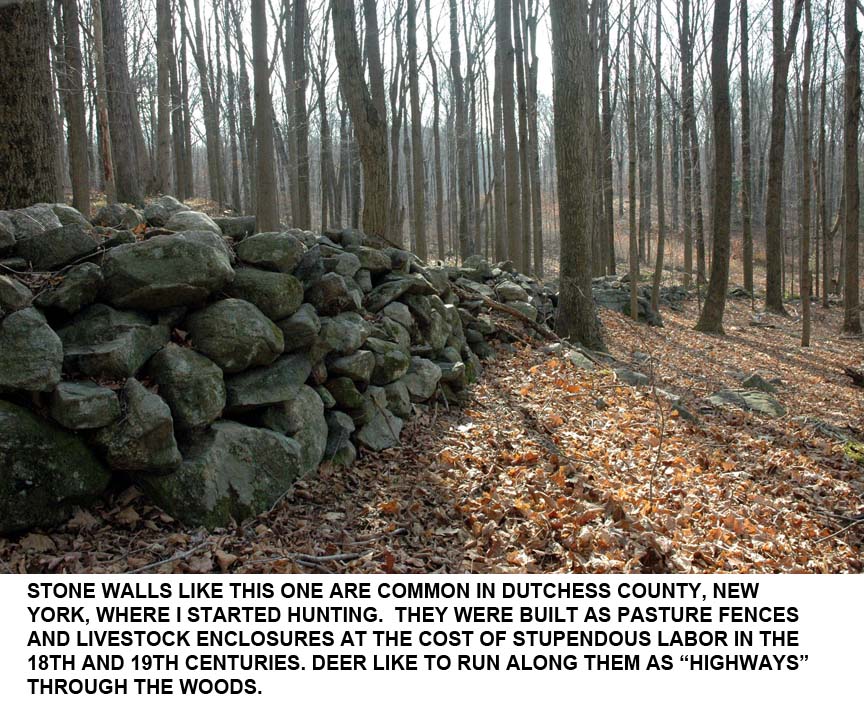
I started hunting as an early teenager in Stanfordville, New York, in Dutchess County. My father owned a house and land I could hunt; I've told the story of my first deer elsewhere. Even now, 40+ years after that kill I could take you to the very spot where it happened, so firmly fixed in my mind is The Stone Wall exactly like the one shown above. This link will take you to a very remarkable treatise on the stone walls of Dutchess County. These walls are characteristic of the land east of the Hudson River, the geographical (if not political) boundary between New York and New England.
SPRUCE RUN FARM
One of the earliest plots of private land to which I was given access was Spruce Run Farm in Giles County. It's a beautiful place with an ideal combination of wooded and open spaces. It's essentially a deer factory: the woods are mostly oaks and hickories, providing food and cover. I don't know how many deer I took on this farm but it was quite a few. I shot my first Virginia deer there, which was also the first one I ever took with a rifle (in New York I'd been required to use a shotgun). I shot my first black powder deer there. Hunting Spruce Run farm taught me a lot; it was a real wrench to lose access to a place that I really valued, as I did after 18 seasons.

On Spruce Run Farm the most significant place was The Fence Join. That farm has been in existence long enough that part of the fence separating the wooded hill from the pasture below is made of split locust wood rails. But at some time in the past the rail fence was extended by the use of "hog wire." Where the two segments come together I named "The Fence Join."

Deer develop movement patterns that take into account the various features of the land and the structures on it. On Spruce Run Farm they tend to move along a well-defined trail through the thick woods well above the fence, entering the pasture by jumping over the split rails a few yards from The Fence Join where the barrier is low enough for them to leap it easily. There's a good sized tree just about at the Join; if I sat behind the split rails next to the tree I was able to watch the entire pasture but the deer really couldn't see me. The woods behind and above me more or less screened me from the other side.
Deer would usually come down the hill headed for the fence, presenting me with a shot. If a deer jumped the fence at some other place, it would almost always walk alongside it—another behavior pattern that seems to be common—eventually coming in range, usually very close range. Since I was invisible I shot several of them at ranges measured in a few feet, not yards, so long as the wind was right.
Another advantage of The Fence Join—one I look for in other spots—is that the farm is on a fairly steep slope so that in the mornings as the ground warms air currents blow uphill. This prevented me from being scented by deer in the pasture; the trail was far enough into the woods that if they scented me while up there it didn't seem to bother them. After all, they'd have been habituated to human scent anyway.
The farmer kept cattle. One day he was driving his tractor in the pasture far below me to feed the cows in the pasture: a nice buck came trotting along outside the fence from my left. He stopped to watch the tractor, a mistake that was his undoing. He took a ball behind his right shoulder, rolled over several times, right down the hill, dropping next to my truck. The range on that shot was about 15 feet! From The Fence Join I later killed several deer planning to jump the fence more or less where I was sitting. One was killed from a distance of less than ten feet.

On this farm also was The Old Barn, from which I made my first black powder kill. I was sitting on the uphill side watching the fence line forty or so yards away when three does galloped right past me almost close enough to touch. I was in plain view wearing full blaze orange but those does—if they could see blaze orange at all, which I don't think they can do—paid me no attention whatever. They weren't legal at the time but I sat tight, figuring a buck would come along after them. So it proved. Ten minutes later a buck came out, running alongside the fence. He stopped to survey the pasture, stamped his hoof a couple of times, then decided it was safe to come down after the does. Again, he paid no attention to the blaze orange figure in plain sight. That was his last mistake: he got a ball through his neck.
This kill demonstrates another important point. I was on the uphill side of The Old Barn. Because the warming wind currents move uphill I was in a "wind shadow." Breezes would flow around The Old Barn, not over me. Had that not been the case the buck would certainly have scented me and headed back into the woods. I've used this "wind shadow" trick many times to good effect in other locations.
Spruce Run Farm is no longer available to me. I hunted it for 18 seasons until the owner decided that a "lease" would pay his property taxes and told me I couldn't hunt there any more. Eventually this man died; the land passed to his son, who gave me permission again, without having to pay any damned "lease" fees. I managed one hunt before the son died at which time the farm passed to his sister who succumbed to the greed that drives all hunting "leases" and again I was shut out of access.
REVALRY FARM
A friend and colleague owned a farm just over the line into Botetourt County where she kept and trained horses. Deer like horses though they don't seem to be overly fond of cows. On Spruce Run Farm if there were cows in the pasture below the fence the deer would almost never come down into it but at Revalry Farm there were only horses, animals that didn't bother the deer at all. Actually I think deer like to be around horses: they're so skittish that anything unusual alerts them. Plus they're taller than deer so they can see potential danger farther away; and their senses of smell and hearing are very nearly as good as a deer's. Horses become a sort of "early warning system" for deer, while cows are so stupid they'll stand there and watch a predator approach without any sign of interest, let alone fear.
Revalry Farm wasn't a big place but it had some interesting features. It was essentially a long pasture with a grassy rise running along one side and a large rocky mountain along the other. This topography created a sort of "chute" in which wind was always channeled along the length of the pasture between the two elevated areas. That predictable wind pattern was a real help.
The rocky outcrop had a creek about 10 yards in front of it, with a screen of brush between the rock and the creek. On the far side of the creek the rock had a sort of "pocket," a hollowed out space where I could sit sheltered from the wind and hidden from sight. The wind, if there were any, would completely pass me by as it blew along the pasture. That small creek—where the deer would come to drink—gave this place the name "The River Styx." My rifle was of course nicknamed "Charon The Ferryman," from the ancient myth about the entrance to Hades and the spirit who ferried the souls of the dead there.


Even though the pasture was fairly wide the ranges at which I got shots were usually short because the deer liked to walk right up the middle of it. Sheltered as I was I could see any deer that came past and even move a bit without being seen, so as to get a better shot. I shot a lot of deer from that "pocket," mostly at well under 35 yards. Nevertheless one of the only two kills I made at a fairly long range came from my seat beside The River Styx. A buck was walking along the pasture on the far side: I later measured the distance at 106 yards. I also made one of my shortest shots there as well: a big six-point waltzed up to the creek, stopping because he'd sensed my presence. He looked straight at me, and got shot in the neck at well under 20 yards. He was dead before he hit the ground and I imagine he still has no idea what happened. I generally don't like neck shots but that one was a "gimme."
Revalry Farm was one of the most productive places I ever hunted but it got sold some years ago when my friend's husband died and she couldn't work the farm on her own.
THREE OAKS FARM
A neighbor and sometime hunting partner's parents live in Amherst County, east of the Blue Ridge so it has a two-deer-per-day limit and either sex is legal. At my age I don't like to wait and freeze my ass off if I can't shoot the first deer I see, so when he invited me to hunt Three Oaks Farm I was delighted.

My favorite spot there was The Rock, a big flat-fronted stone overlooking a shallow draw and a trail the deer like to use. Again, the location and geography of The Rock afford me a "wind shadow," protection from being seen unless the deer is in front, and back support. But the very first deer I killed from The Rock was walking along the trail directly below me; she never looked up and that was her biggest error. Over the years I think I killed at least 5 deer from The Rock, probably more. One day I heard a deer behind The Rock, peeped out and there was a buck. I had a muzzle loader that misfired: a "POP!" as the cap went off but no BANG! The deer started looking around, wondering to himself, "What the hell was that noise?" I frantically re-capped the rifle, popped up again, and this time it went BANG!
Another place on Three Oaks Farm is Behind The Little House (a guest cottage). There's a deep draw that comes down off the nearby road to Huff Creek. Deer come down the hill after crossing the road, hop across the creek at the bottom, and walk up to the field in front of the main house. I shot several deer in that place, too.
I no longer hunt Three Oaks Farm much for a variety of reasons, but might go back there some day.
BROOKSIDE FARM
This is one of my current and most favored locales. A friend and colleague lives in Newport, a village about 12 miles from my home. She has a plot of 160+ acres, mostly wooded, and well "stocked" with deer. I've hunted that property for 20+ years and hope to do so until I can't hunt any more.
The topography of Brookside Farm is such that there's a sort of "saddle" in the middle as you come up from the road. I walk up a long and fairly steep slope (as I age it gets longer and steeper, but I digress) into a flat area known as The Riding Ring; then down again into the woods on the other side to a place I call "The Valley Of A Thousand Rodents." I did (and do) a lot of squirrel hunting there, hence the name I use for it.

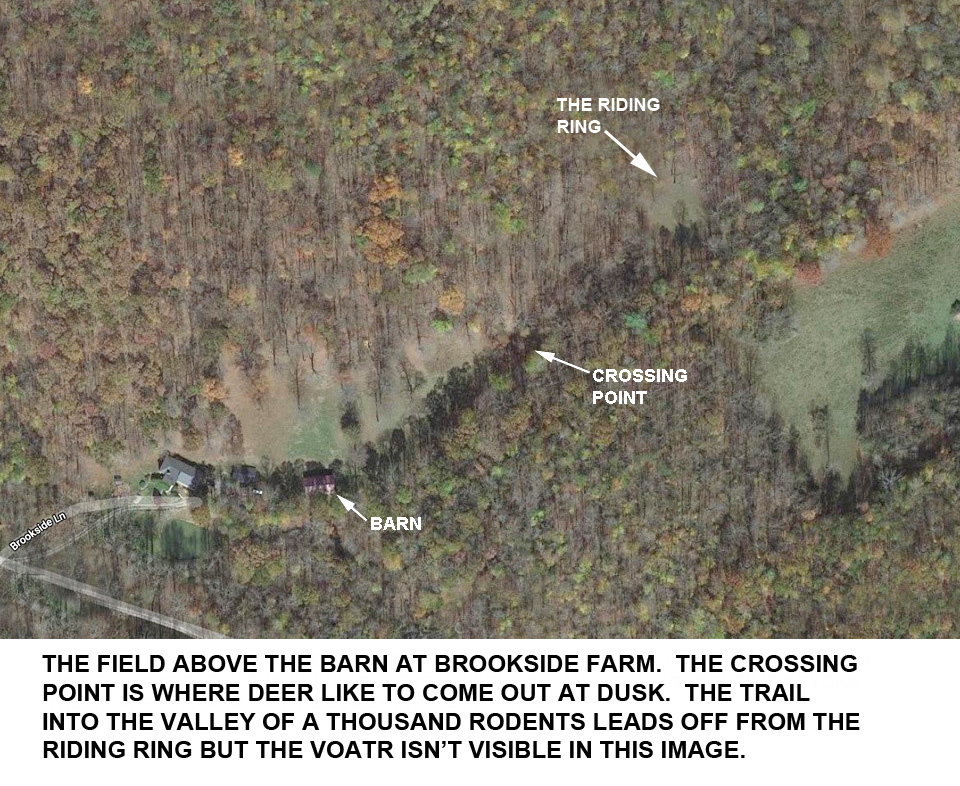
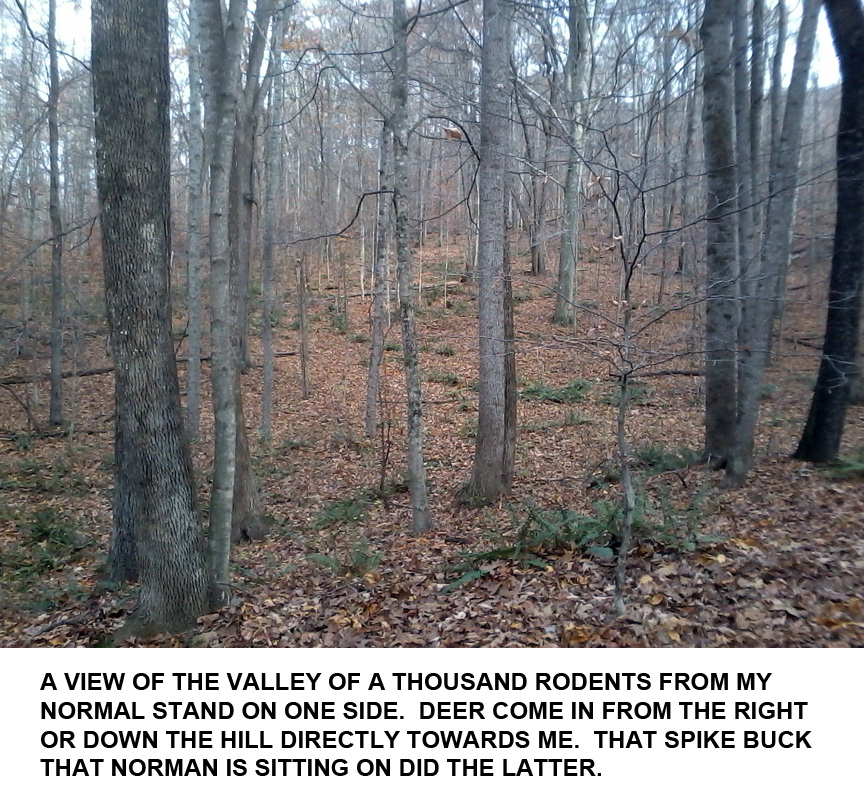
Deer love the VOATR because it's a sheltered area where three of their trails intersect. It's shielded from view (so they like to they think) and grown up in oaks and beeches with a relatively open floor. There are high slopes on both sides, on one of which of which I like to sit overlooking the floor where the trails come together. When deer come in they cross the opposite slope less than 50 yards away; or they come down the trail into the VOATR from the end of that slope. Then they're moving towards me. Thanks to the dense woods the longest possible shot is at most 80 yards. Again, I'm more or less invisible from behind, and again, and I'm looking down.


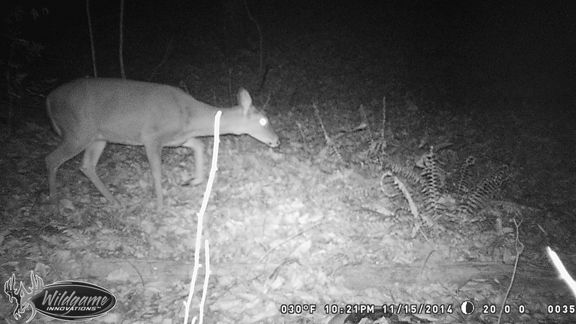 An oddity of the VOATR is that I've never killed a doe there: only bucks. Mostly I get spikes and forkhorns, but it also has produced the two biggest bucks I've ever taken, a big 8-point and a nice 9-pointer, both from the same spot. Does certainly do come through: I've seen them on my game camera, but when I'm there it seems to be Buck Central. I've shot at least 15 deer in the VOATR, probably more, plus numerous squirrels.
An oddity of the VOATR is that I've never killed a doe there: only bucks. Mostly I get spikes and forkhorns, but it also has produced the two biggest bucks I've ever taken, a big 8-point and a nice 9-pointer, both from the same spot. Does certainly do come through: I've seen them on my game camera, but when I'm there it seems to be Buck Central. I've shot at least 15 deer in the VOATR, probably more, plus numerous squirrels.
Another plus: there are bears. I'm not a bear hunter and would only shoot one in self-defense, but I've seen bears out there more than once. One time it was a Mama bear with three cubs bouncing along in her wake. They were fifty feet away and all I had was a pea-shooter of a .32 muzzle-loader! Luckily Mama didn't scent or spot me!
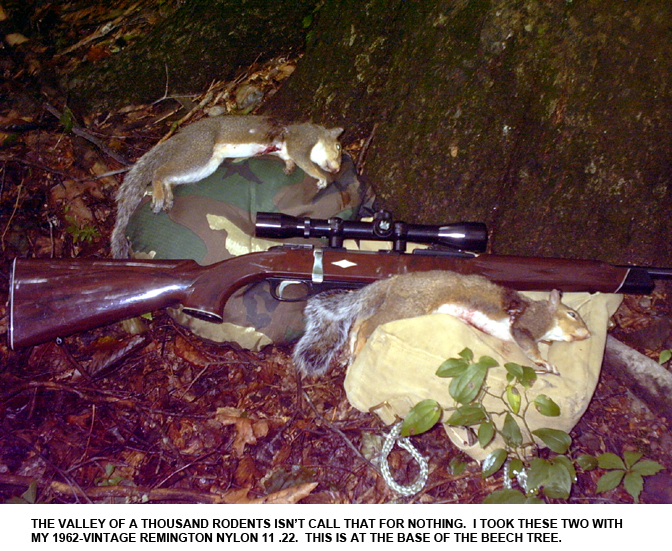

In the VOATR, across from where I usually sit there's The Beech Tree, one of my favorite spots for squirrels. I've killed only one deer from The Beech Tree, but many a squirrel has incautiously exposed himself to me when I was at the base of it.
Sometimes I don't feel like trudging up the long hill to the VOATR, so I sit and watch The Field Above The Barn, another reliable spot. The Field Above The Barn seems to be an "evening" location: deer come down from the woods just about dusk. I like that timing, it means I don't have to get up at 4:00 AM! I can either sit on the side just at the property line to overwatch or if the weather is nasty I can sit under the barn's overhang, out of the wind. I shot the first and only deer I ever took with a flintlock in The Field Above The Barn. I'm not sure which one of us was more surprised at that.

Mostly I get does and button bucks in The Field Above The Barn (although that flintlock deer was a decent buck). One season I'd shot a button buck and then, two days later I shot a big doe there, not fifty feet from the place where the buck had fallen. The ranges tend to be fairly long compared to the VOATR, but not so long that I can't "reach out and touch someone" with my .308.
The Field Above The Barn was also the site of a really irritating incident. Well, two. I'd been sitting with my back against a stump and...ahem...dozed off. I was awakened by very slight noise; opened my eyes to see the biggest buck I'd ever encountered in my life (at least a 12-point) staring at me from perhaps 7 feet away. We both said to ourselves "Holy Shit!" but he was faster than I was: gone over the fence into the next property in a flash of white tail before I could get the gun up. Some years later nearly the same thing happened in exactly the same spot. I'd been watching the Field when I heard a tiny noise behind me, turned, and came face to face with a buck on the other side of my stump—the very same stump. Off he went, no chance for a shot at all.
The flat space just before going down into the VOATR is called The Riding Ring because my friend kept a horse for her daughters for many years. I've seen deer in The Riding Ring many times but never killed one: I did however humiliate myself by firing FOUR TIMES at a doe 50 yards away using the .30-30 rifle barrel on a Savage combination gun. Unbeknownst to me the rear sight had been knocked badly askew. The bullets went over her back and far to the right. I could see that deer looking around for the source of the noise and thinking to herself, "What was that?" before she ambled off and I found out what was wrong.
My friend's mare gave me a fright once: not because I'm afraid of horses—most of them are so stupid they don't realize that having steel-shod feet and weighing half a ton, they could kill a man whenever they liked—but because that one got out one day when I was retrieving a deer I'd shot in The Field Above The Barn. I'd had to open the gate to get my truck through and that damned mare had wandered down from the Riding Ring and through the gate before I could get it shut again. I didn't want to have to explain to my friend that her daughter's horse had been killed on US 460 by a tractor-trailer (a pretty likely outcome for a 900-pound animal with a brain the size of an apricot). I had a hell of time getting her back into the Field: it took half an hour or so of doing my "Horse Whisperer" imitation before I could get a rope around her silly neck and lead her back in beyond the gate. She has now gone to The Great Pasture In The Sky, and the daughter is off on her own, so this won't happen again (I hope).
SUNRISE FARM
A former student told me one day that her stepfather had a lot of deer on his land and would I like to hunt there? You bet I would! I've been hunting it for several years with great success. Along with Brookside Farm this is one of my favorite places.
Sunrise Farm is not only a farm, it's a lumbering operation. The owner has a lot of valuable hardwood trees and manages the land for them. Not incidentally, since most of these are oaks and hickories, he manages it for deer as well, though he has little use for them. He has enrolled the property in the Department of Wildlife Resources' DMAP (Deer Management Assistance Plan) program. Every year he gets somewhere between 10 and 15 additional tags that are good for antlerless deer. Deer killed on DMAP tags don't count against a hunter's basic license allowance, nor is there a limit on how many of those DMAP deer can be killed on a single day. Normally the daily limit is two, but with DMAP the only limit is how many tags are available. So Sunrise Farm is really the "Happy Hunting Ground." And indeed there are lots of deer. I see them every time I go out, whether it's to hunt or scout in the off-season. I don't care about antlers because I can't eat them, so the "antlerless only" restriction doesn't bother me in the least.
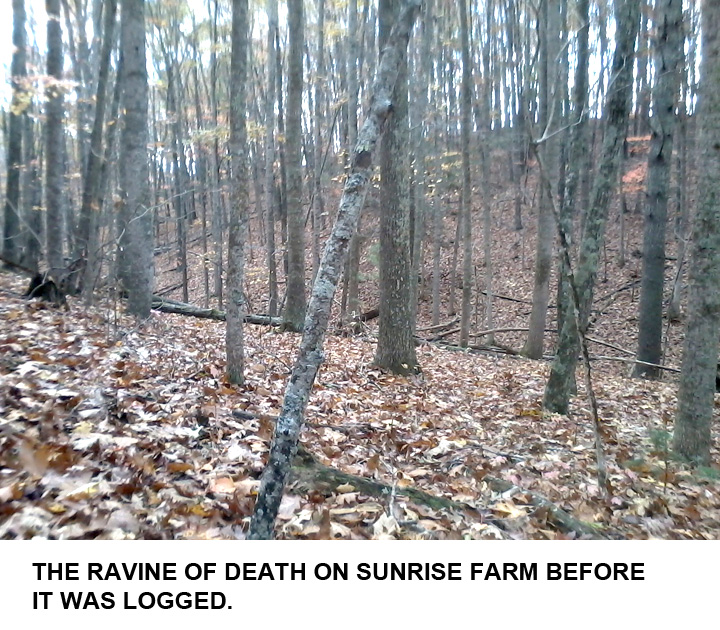
There were (are) any number of good spots on Sunrise Farm. Early on I opted to hunt what I called The Ravine Of Death. The ROD is between two hills: one hill flanks the road past the property, the other rises between the house/barn complex. The ROD is fairly steep on both sides.
 One of my favorite spots in the ROD was called Three Trees. As the name implies, it was a location where three reasonably good sized trees had grown up in a sort of triangular formation. Next to it was a woodpile, screening me from view. I could see down into the ROD, but couldn't easily be seen. I killed probably a dozen deer in the ROD until it became un-huntable, for reasons I'll describe below.
One of my favorite spots in the ROD was called Three Trees. As the name implies, it was a location where three reasonably good sized trees had grown up in a sort of triangular formation. Next to it was a woodpile, screening me from view. I could see down into the ROD, but couldn't easily be seen. I killed probably a dozen deer in the ROD until it became un-huntable, for reasons I'll describe below.
On the upper side of the ROD between it and the house/barn complex is a flat space. There was a very large tree there against which I could sit, which I dubbed "The Throne" because it had two big logs on either side of the base of the tree, like arms on a chair. One of the fastest kills I made from The Throne before it too became un-huntable was a doe at all of 10 yards. She hopped into the air and came down stone dead.
About three years ago the landowner had the place logged off: monster machines came in and started cutting down trees and hauling the logs out. This was pretty distressing. The ROD became choked with "slash," the debris of downed limbs and stumps left behind. The big tree at The Throne was cut down; the Three Trees stand was obliterated by slash. I was pretty unhappy but of course couldn't say anything about it, it's not my land. One of the loggers told me, however, "Don't worry, there are still plenty of deer here, we see them all the time." He was right.
Three years on there are in fact recognizable benefits from the logging operation. The huge tangles of slash that really complicate recovery also provide a lot of very good cover that the deer like. The removal of larger trees allowed light to reach the floor, permitting new growth to spring up. That created a new source of browse, certainly something the deer must appreciate.
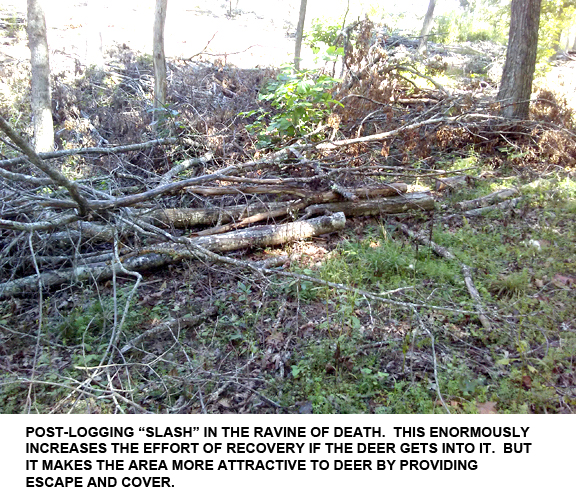

From my point of view the biggest benefit was that the loggers built semi-roads into the depths of the property so they could get their logs out. One of these skidder trails has allowed me access to areas I couldn't get to before. It simultaneously created a way into the best spot I've found so far while permitting me to use my truck for recovery. That spot is The Nine-Deer Dip, a shallow depression almost at the end of the logging trail. It got its name because one day I spotted nine deer walking calmly across the semi-road. Sunrise Farm is always a reliable place to see deer, but The Dip is the most productive spot on it. In the past two seasons I've taken 3 deer there, two of them a week apart.
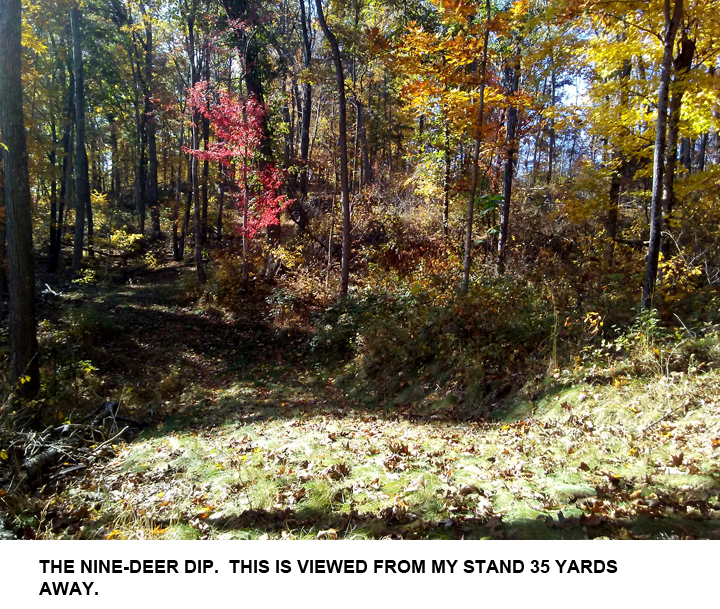
The stand I use at The Dip is one of the most comfortable I've ever found. Not only is there a tree to lean against, there's a log on which I can brace my feet for a shot (I shoot best from a sitting position). I can see deer moving through The Dip all of 35 yards away, and sometimes spot them in the tangled slash above, working their way down the hill. If they come along the logging road I'll see them; if they come from the other direction all I have to do is sit and wait until they come in range. It's about as ideal a spot as I could wish.

The one time I successfully used spot-and-stalk in Virginia took place at Sunrise Farm. I'd been out all morning and by 9:00 I was getting cold so I went and sat in my truck to warm up. Twenty minutes later, I glanced into the rear view mirror, and a deer was walking past behind the truck! He ambled down the lane leading to the landowner's house. I quietly opened the door, and stole out after him.
This deer was pretty unconcerned about being followed by a human in blaze orange. He kept going down the lane, where I had no shot because of farm buildings in the background, then turned to his left and entered into the east end of the woodlot headed for The Ravine Of Death. I followed him in. He was obviously very naive, because he'd let me get within 35-50 yards then he'd keep moving. But he never put his tail up and he wasn't running at all. I'd never tried to stalk a deer before, and I suspect that had this one not been a total innocent, I'd not have had a prayer of doing so successfully. But he led me deeper into the woods, stopping two or three times to look back at me. I could tell he was thinking, "What the hell is that?" Eventually it began to dawn on him that maybe things were not quite the way he would have wished. Eventually he stopped and stood broadside to me, facing to my left, and watched me warily from about 50 yards.

I assumed he was going to wise up and bolt, so I took the chance: he was in the clear, I could see nothing between me and him, and up came the rifle. I fired, at about 50 yards, from the offhand position. He fell instantly. He was stone dead when I got to him. A foolish button buck, undoubtedly born the previous Spring. No spots (it was October 31st) so his coat was the grey-brown of a winter deer. The bumps where his antlers would have grown were covered with hair, so legally he was "antlerless," but antlerless deer are legal in that county in the BP season. He wasn't big, maybe 75 pounds live weight, but still, a deer. I was pleased with that offhand shot. The bullet hit exactly where I'd aimed. There was a massive amount of blood in the chest cavity, as might be expected.
As I get older I find I'm less and less inclined to look for new spaces and places to hunt. I have no doubt that in the fairly near future my options will continue to be limited, not because no one will allow me to hunt but simply because my enthusiasm wanes and I think about opting out. That time is coming when I won't want to hunt much at all; I hope not for years to come, but come it will. When that moment arrives I'll be able to look back at the places I've been and the memories I have of them—there are many, many more than I have recounted here—and be satisfied with that. But inevitably time and wear-and-tear will take their toll. Soon there will just be memories. I hope that I'll be able to pass on some of my experiences and memories to a new generation of hunters who will do the same in their turn. That will have to be enough.
| OPENING PAGE|
|SEASON LOGS |
| HUNTING | GUNS | DOGS |
| FISHING & BOATING | TRIP REPORTS | MISCELLANEOUS ESSAYS |
| CONTRIBUTIONS FROM OTHER WRITERS|
| RECIPES |POLITICS |